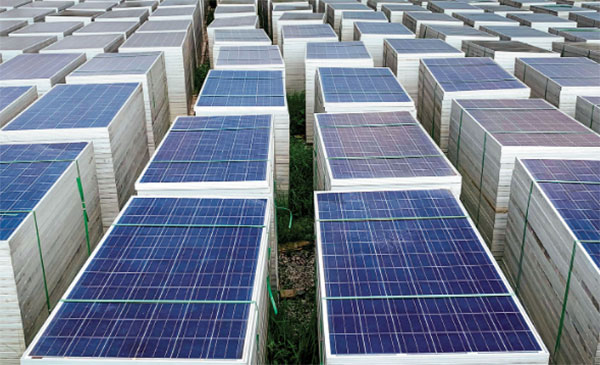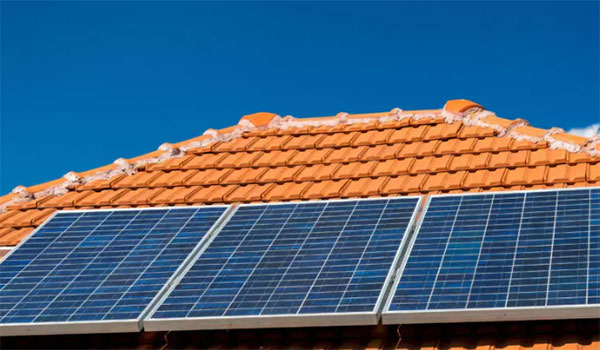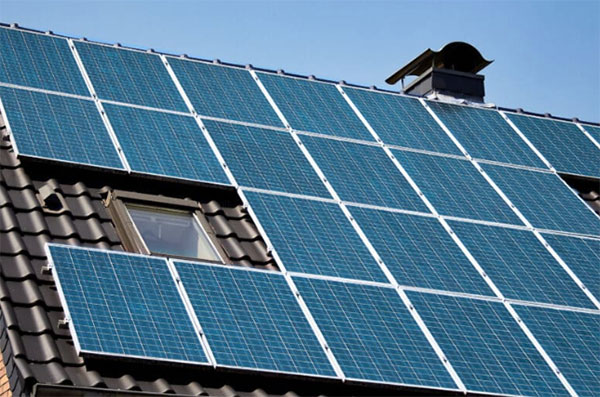What is the average output voltage of a silicon solar cell in direct sunlight
2024-03-08
Description
The most expensive component of solar panels is the high-purity silicon used in solar cells, due to its complex manufacturing process.Basics of Silicon Solar Cells
Silicon solar cells are a cornerstone of solar energy technology, harnessing sunlight to produce electricity. This section delves into the intricacies of their structure, working principle, and the key components that influence their performance.Structure and Working Principle
Silicon solar cells convert sunlight into electricity through the photovoltaic effect. They are composed of a p-type silicon layer and an n-type silicon layer, creating a p-n junction. When sunlight hits the cell, photons knock electrons loose, allowing them to flow and generate electricity. This process is fundamentally influenced by the cell's design and material quality.Key Components Affecting Performance
Several crucial factors determine the efficiency and output of silicon solar cells:- Material Quality: High-purity silicon leads to higher efficiency rates. Impurities in the silicon can create sites where electrons recombine with holes, reducing the cell's efficiency. The typical efficiency of commercial silicon solar cells ranges from 15% to 22%.
- Cell Design: The design, including the thickness of the silicon wafer and the configuration of the front and back contacts, significantly impacts performance. Advanced designs, such as PERC (Passivated Emitter and Rear Cell), have pushed efficiencies higher by reducing electron recombination.
- Surface Coating: Anti-reflective coatings are applied to the surface of the cell to reduce the loss of sunlight through reflection. These coatings are crucial for maximizing the absorption of sunlight.
- Temperature: Solar cell performance decreases as temperature increases. The voltage output of a silicon solar cell drops by about 0.4% for every 1°C increase in temperature.
- Light Intensity: The output power of a solar cell increases linearly with increasing light intensity, up to a certain point. However, very high light intensities can also heat the cells, countering some of the gains in output power.
Factors Influencing Silicon Solar Cell Voltage
The output voltage of silicon solar cells is a critical parameter that determines their efficiency in converting sunlight into electrical energy. This voltage is influenced by several factors, including sunlight intensity, temperature, and the inherent design and material quality of the solar cell. Understanding these factors is essential for optimizing solar cell performance and maximizing energy production.Impact of Sunlight Intensity
Sunlight intensity directly affects the amount of electric current generated by a solar cell. As sunlight intensity increases, the photogenerated current increases, leading to a higher output voltage. The relationship between light intensity and output voltage is linear up to a certain point, beyond which further increases in light intensity produce diminishing returns on voltage increase. For instance, doubling the sunlight intensity can increase the short-circuit current proportionally but has a lesser effect on the open-circuit voltage.Temperature Effects on Output Voltage
Temperature has a significant inverse effect on silicon solar cell voltage. As the temperature rises, the semiconductor material's bandgap decreases, leading to a reduction in open-circuit voltage. A typical silicon solar cell might see a decrease in voltage of about 0.4% per degree Celsius increase in temperature. This temperature sensitivity underscores the importance of thermal management in solar panel installations, especially in hot climates.Influence of Solar Cell Design and Material Quality
The design and material quality of a silicon solar cell are pivotal in determining its voltage output and overall efficiency. High-purity silicon materials with fewer crystallographic defects allow for better charge carrier mobility, reducing recombination losses and increasing voltage. Advanced cell designs, such as those incorporating back-contact technologies, can further enhance voltage by minimizing electron path lengths and resistance.- Material Quality: The purity of silicon used in solar cell manufacturing has a profound impact on its performance. Higher purity silicon results in a higher potential voltage output due to reduced electron-hole recombination.
- Cell Design: Innovations in solar cell design, including the use of passivation layers and selective doping, can significantly improve voltage output. For example, PERC (Passivated Emitter and Rear Cell) technology has been shown to enhance both the efficiency and voltage output of silicon solar cells.
Measuring the Average Output Voltage
Measuring the average output voltage of silicon solar cells is crucial for evaluating their performance and efficiency. This process is governed by specific standard test conditions and involves precise experimental methods and equipment. Understanding these factors is essential for accurate measurement and comparison of solar cell performance.Standard Test Conditions for Voltage Measurement
Standard Test Conditions (STC) provide a controlled environment to ensure that the performance of solar cells can be compared on a like-for-like basis. These conditions include:- Light Intensity: 1000 W/m^2, simulating sunlight at noon on a clear day.
- Temperature: 25°C (77°F), considered the standard temperature for testing.
- Air Mass: 1.5, representing the spectrum of sunlight passing through the Earth's atmosphere.
Experimental Methods and Equipment
To measure the average output voltage of a silicon solar cell accurately, specific experimental setups and equipment are used:- Solar Simulator: A device that mimics natural sunlight, providing a constant and controllable light source with a spectrum similar to that of the sun under STC.
- Multimeter or Voltmeter: Precision instruments used to measure the voltage output of the solar cell. These devices must be calibrated and sensitive enough to detect small variations in output.
- Temperature Control: Since temperature affects solar cell voltage, maintaining the cell at a constant temperature (usually 25°C) during testing is critical. This is often achieved using a temperature-controlled chamber.
- Positioning the Solar Cell: The cell is placed under the solar simulator, ensuring even illumination across the entire surface.
- Setting the Simulator: The light intensity is set to 1000 W/m^2, and the spectrum is adjusted to match air mass 1.5 conditions.
- Temperature Stabilization: The solar cell is allowed to reach the ambient temperature of 25°C before measurements are taken.
- Voltage Measurement: The multimeter is connected to the solar cell's contacts, and the voltage is measured under open-circuit conditions.
- Ensuring the solar simulator's light intensity and spectrum accurately reflect STC.
- Monitoring and adjusting the temperature of the solar cell to maintain standard testing conditions.
- Calibrating the measurement instruments before conducting the experiment to ensure accuracy.
Comparative Analysis of Silicon Solar Cell Voltage
Understanding the voltage characteristics of silicon solar cells and how they compare with other photovoltaic materials is essential for optimizing solar energy systems. This analysis delves into the voltage variations among different types of silicon cells and compares them with other photovoltaic materials, highlighting efficiency, cost, lifespan, and material quality.Voltage Variations Among Different Silicon Cell Types
Silicon solar cells can be broadly classified into three main types: monocrystalline, polycrystalline, and thin-film silicon cells. Each type has distinct voltage characteristics due to differences in material quality, manufacturing processes, and cell design.- Monocrystalline Silicon Cells: Known for their high efficiency and purity, monocrystalline silicon cells typically have higher voltage outputs due to their uniform crystal structure. Efficiencies can reach up to 22%, with voltage outputs slightly higher than their counterparts.
- Polycrystalline Silicon Cells: These cells are made from silicon crystals that are melted together. While cheaper to produce than monocrystalline cells, they have a lower efficiency (15% to 18%) and, consequently, a lower voltage output due to the presence of multiple crystal boundaries that can impede electron flow.
- Thin-Film Silicon Cells: The thinnest of all silicon types, these cells have the lowest efficiency (about 10% to 13%) and voltage output. However, they are the least expensive to manufacture and offer flexibility in applications.
- Material Quality: Higher purity silicon in monocrystalline cells results in higher voltage outputs.
- Manufacturing Process: The simpler crystal structure of monocrystalline cells, compared to polycrystalline, enhances their performance.
- Cost vs. Efficiency: While monocrystalline cells offer higher efficiency and voltage, they are also more expensive than polycrystalline and thin-film silicon cells.
Comparison with Other Photovoltaic Materials
Silicon solar cells are not the only option for photovoltaic applications. Other materials like cadmium telluride (CdTe), copper indium gallium selenide (CIGS), and perovskite offer alternative solutions with varying efficiency, cost, and voltage characteristics.- Cadmium Telluride (CdTe): CdTe solar cells offer efficiencies around 22%, similar to high-end silicon cells. However, concerns over cadmium's toxicity and environmental impact can limit their application.
- Copper Indium Gallium Selenide (CIGS): CIGS cells can achieve efficiency levels up to 20%. They have a higher voltage output compared to thin-film silicon cells due to better absorption of sunlight.
- Perovskite Solar Cells: A promising new technology, perovskite cells have shown efficiencies exceeding 25% in the lab. Their voltage output is competitive with monocrystalline silicon cells, but long-term stability and scalability remain challenges.
- Efficiency and Voltage: Non-silicon materials like CdTe and CIGS can offer comparable or higher efficiency and voltage outputs than silicon-based cells.
- Cost and Lifespan: While alternative materials may provide higher efficiency, the cost, lifespan, and environmental impact of these materials vary widely and can affect their overall value proposition.
Optimizing Output Voltage in Silicon Solar Cells
Maximizing the output voltage of silicon solar cells is crucial for enhancing the efficiency and effectiveness of solar energy systems. This optimization involves a combination of technological advancements and strategic approaches designed to improve the cells' performance under direct sunlight.Technological Advances for Efficiency Improvement
Advancements in silicon solar cell technology have been pivotal in increasing their efficiency, directly impacting the output voltage. Innovations include:- Passivated Emitter and Rear Cell (PERC) Technology: PERC enhances light absorption and electron capture, significantly boosting efficiency and voltage. Efficiency improvements of up to 22% have been observed with PERC technology.
- Heterojunction Technology (HJT): HJT combines crystalline silicon with amorphous silicon layers, reducing electron recombination and increasing voltage output. HJT cells can achieve efficiencies above 24%.
- Advanced Anti-Reflective Coatings: These coatings improve light absorption, directly contributing to higher voltage outputs. Innovations in coating materials and application techniques have led to significant efficiency gains.
- The use of high-purity silicon significantly reduces impurities that can trap electrons and lower voltage.
- Tailoring the doping levels and patterns within the silicon can enhance the electric field strength across the cell, improving the voltage output.
Strategies for Maximizing Voltage Output in Direct Sunlight
Optimizing silicon solar cells for direct sunlight exposure involves several strategic approaches:- Temperature Management: Implementing cooling technologies or choosing materials with lower thermal coefficients can minimize efficiency losses due to heat. A typical silicon solar cell's voltage output decreases by 0.4% for every 1°C increase in temperature.
- Light Trapping Techniques: Structures that enhance the path length of photons within the cell can increase the probability of absorption and electron excitation, boosting voltage output.
- Optimal Orientation and Tracking: Aligning solar panels to face the sun directly and using tracking systems to follow the sun's path can maximize light exposure, significantly enhancing voltage output during peak sunlight hours.




